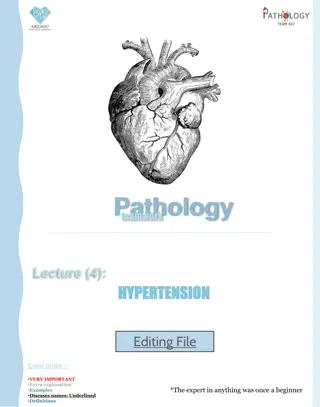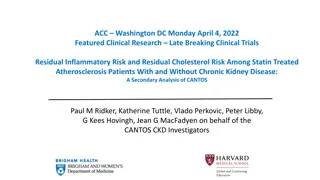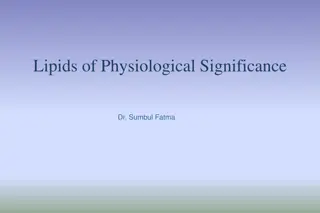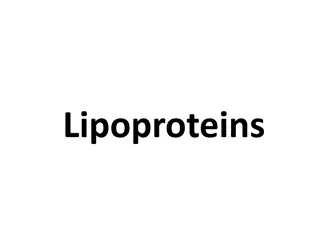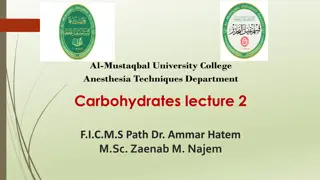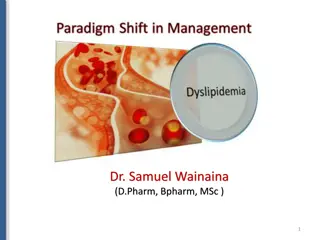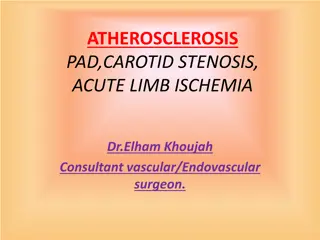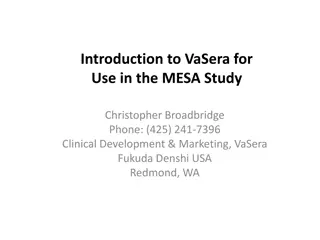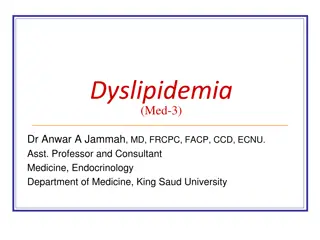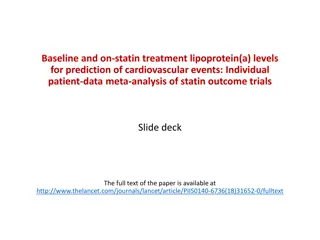Lipoprotein and Atherosclerosis
Understand the correlation between lipoprotein metabolism imbalance and the development of atherosclerosis. Learn about LDL and HDL cholesterol metabolism, receptor-mediated endocytosis, and the role of lipoprotein(a).
Download Presentation

Please find below an Image/Link to download the presentation.
The content on the website is provided AS IS for your information and personal use only. It may not be sold, licensed, or shared on other websites without obtaining consent from the author.If you encounter any issues during the download, it is possible that the publisher has removed the file from their server.
You are allowed to download the files provided on this website for personal or commercial use, subject to the condition that they are used lawfully. All files are the property of their respective owners.
The content on the website is provided AS IS for your information and personal use only. It may not be sold, licensed, or shared on other websites without obtaining consent from the author.
E N D
Presentation Transcript
Lipoprotein and Atherosclerosis L:5 W:5 Color Index: Main text Important Notes Boys slides Girls slides Extra
objectives Correlate the imbalance in lipoprotein metabolism with the development of atherosclerosis Understand the functions and metabolism of LDL and HDL cholesterol Describe the receptor-mediated endocytosis of LDL and its regulation Recognize how LDL is considered a bad cholesterol whereas HDL a good cholesterol Understand the biochemistry of atherosclerosis and its laboratory investigations Discuss the role of lipoprotein(a) in the development of heart disease Overview Receptor-mediated endocytosis of LDL and its regulation LDL is bad cholesterol High density lipoprotein (HDL) and its functions Metabolism of HDL HDL is good cholesterol Atherosclerosis Lipoprotein(a)
Overview Cholesterol homeostasis is a balance between cholesterol transport: 2. From peripheral tissues to the liver by HDL 1. From the liver to peripheral tissues by LDL Imbalance in the above leads to: 1. Cholesterol deposition in blood 2. Thickening and narrowing of the lumen of arteries 3. Atherosclerosis vessels 4. Heart disease
Receptor-mediated endocytosis of LDL particle Binding of Apo B-100 to LDL receptor glycoprotein The LDL receptors are more concentrated on the coated pit of the cell surface (coated by clathrin) Endocytosis 1 2 Endosome formation (LDL vesicle fuses with other vesicles) 3 4 Separation of LDL from its receptor Receptor is recycled 5 LDL degraded by lysosomes releasing: Free cholesterol, fatty acids, amino acids, phospholipids 6
Regulation of LDL endocytosis Special thanks to team 441 Up regulation: Down regulation: Low intracellular cholesterol level causes: High intracellular cholesterol level causes: Degradation of LDL receptors Recycling of LDL receptors Increased receptor synthesis What will we do ? Inhibition of receptor synthesis at gene level Increased receptor synthesis at gene level how? Increase in cell surface receptors What will happen? Reduction in cell surface receptors increase uptake of LDL by cells The result? Decreased uptake of LDL by cells Increased de novo (new) synthesis of cholesterol Anything else can help? Decreased de novo synthesis of cholesterol
High density lipoprotein (HDL) Nascent HDL: Mature HDL: Nascent HDL + cholesteryl esters HDL3 Disk-shaped HDL3+ more cholesteryl esters spherical HDL2 Contains apo A-I, C-II \and E lipoproteins Mainly contains phospholipids HDL2transfers cholesterol to the liver
Functions of HDL Suitable for cholesterol uptake due to: Transports cholesterol to liver from: Reservoir of apoproteins (Apo C-II and E) 1- High content of phospholipids Cell Peripheral tissues Other lipoproteins membranes 2- Phospholipids solubilize cholesterol and provide fatty acids for cholesterol esterification
HDL metabolism Extra slide from doctors notes Special thanks to team 441 Small intestine releasing discoidal nascent HDL (immature HDL) 1 (PC =phosphatidylcholine) = (lecithin) so we can say LCAT or PCAT LCAT = lecithin-cholesterol acyltransferase Free cholesterol is removed from peripheral tissues by ABCA1 2 Free cholesterol is then transformed to cholesteryl esters before it fuses with HDL by LCAT which taked a fatty acid from phosphatidylcholine (pc) and gives it to the free cholesterol. The pc is then converted to lysosomal phosphatidylcholine as a byproduct this mechanism allows the binding of free cholesterol to nascent HDL producing HDL3 3 HDL3 collects more tissue cholesterol to form HDL2 (mature HDL) 4 HDL2 gives some of its cholesteryl esters to vldl using cholesteryl ester transferase protein (cept) and and the rest goes to liver by binding to SR-B1 which converts HDL2 back to HDL3 using hepatic lipase 5 SR=scavenger receptor and some are found in macrophage and play a role in atherosclerosis (SR-A)
HDL LDL (GOOD CHOLESTEROL) (BAD CHOLESTEROL) HDL transports cholesterol from peripheral tissues to the liver for degradation Transports cholesterol to peripheral tissues High HDL levels have inverse correlation with atherosclerosis Elevated LDL levels increased risk for atherosclerosis / heart disease Reduces cholesterol level in tissues and circulation (reverse cholesterol transport) Deficiency or defects in LDL receptors results in: Decreased uptake of cholesterol by cells Increased accumulation of cholesterol in blood vessels Familial hypercholesterolemia Reverse cholesterol transport includes: Cholesterol efflux from peripheral tissues to HDL liver Patients are unable to clear LDL from blood Premature atherosclerosis and heart disease Cholesterol esterification Binding and transfer of cholesteryl ester-rich HDL2to Release of lipid-depleted HDL3
6-Cholesteryl esters accumulate in macrophages converting them to foam cells. *(foam cells contribute to plaque formation And atherosclerosis). 1-LDL uptake by cells is receptor mediated.(specific uptake) 5-Unlike LDL receptors,the SR-A is not down-regulated in response to high intracellular cholesterol. 2-Additionally, macrophages possess scavenger receptors called scavenger receptor class A (SR-A). (not specific uptake, can react with other molecules) Atherosclerosis 4-Chemically-modified LDL contains oxidized lipids and Apo B (some free radicals attack lipids and oxidize them) 3-The macrophages take up chemically-modified LDL by endocytosis.
Atherosclerosis *Belongs to the previous slide -In response to endothelial injury (caused at least in part by oxidized LDL) monocytes adhere to endothelial cells, move to the subendothelium (intima), and are converted into macrophages. -Macrophages consume excess modified (oxidized) lipoprotein, becoming foam cells. -Foam cells accumulate, releasing growth factors and cytokines that stimulate the migration of smooth muscle cells (SMCs) from the media to the intima. There, the SMCs proliferate; produce collagen; and take up lipid, potentially becoming foam cells. -Low-affinity, non-specific and non-regulated scavenger receptors take up modified (oxidized) LDL (oxLDL). -High-affinity receptors specific for LDL are downregulated when the cell has sufficient cholesterol. *Animation 01 02 03 04 05 -It will be either increase in the free radicals (left side)or deficiency in the antioxidants (right side). That lead to modify LDL onto oxLDL, which can react with SR-A despite the cholesterol level. 06
Lab investigations of atherosclerosis Serum apo-protein levels (e.g., apo-B) This test measures the amount of apo-B in the blood. (the protein portion of apolipoprotein)
Lipoprotein (a) LDL + apo a = Lp(a) -Lp(a) is identical in structure to LDL particle. -Contains apo(a) in addition to apo B-100. -High plasma Lp(a) level is associated with increased risk of coronary artery disease. -Circulating levels of Lp(a) are determined by: 1- Genetics (mainly). 2- Estrogen (decreases Lp(a) levels). 3-Diet(trans FAs increase Lp(a) levels). -The apo(a) protein is structurally similar to plasminogen Competes with plasminogen blood clots Plasminogen is an enzyme that turns into plasmin which needed in blood clot degradation (keep the blood flow and breakdown thrombus) Since apo(a) is similar to plasminogen it will mislead the factor that activate plasminogen (= it won t turn into plasmin). Which will stop the fibrinolytic pathway and the thrombus won t be broken down. A risk factor for coronary heart disease ( CAD ) Slows the breakdown of Triggering heart attack
Take Home Messages Imbalance in the LDL and HDL metabolism causes increased accumulation of lipids in the body LDL is bad cholesterol whereas HDL is good cholesterol The pathogenesis of atherosclerosis includes the uptake of oxidized LDL by macrophages through scavenger receptor class A (SR-A) producing foam cells andatherosclerotic plaque Individuals with high level of plasma Lp (a) are at higher risk for coronary heart disease
SUMMARY CLICK HERE SHOUT OUT TO TEAM441
MCQs Q1:The banding of on the LDL particle to the LDL receptor Glycoprotein in the cell surface A: C-II B: C-I C: B-100 D: B-48 Q2: Nascent HDL shape is shaped A: Biconcave B:Round C:Tringuler D:Disc Q3: HDL2 gives cholesteryl ester to the liver and VLDL by what ?(liver/VLDL) A:(SCAP/ABCA1) B:(SR-A1/CEPT) C:(SR-A1/SCAP) D:(SR-B1/CEPT) SR=scavenger receptor and some are found in macrophage and play a role in atherosclerosis
MCQs Q4:Circulating levels of Lp(a) are determined by: A: Genetics. B: Estrogen. C: Diet. D.All of the above. Q5:In atherosclerosis, The fasting serum investigations will show that the LDL will be ., and HDL will be . .. A: Low,high B: High,low C: Low,low D: High,high Q6:In atherosclerosis, High-affinity receptors specific for LDL are . when the cell has sufficient cholesterol. A: Upregulated. B: Downregulated. C: Remains the same. D: /
SAQs Q1: list three effects of the up-regulation of LDL endocytosis Q2:list three functions of HDL Q3: Mention the lab investigations in Atherosclerosis? Q1:slide(5) Q2:slide(7) Q3: slide(13)
Our Team Leaders Team members Mashael Alsuliman Shahad Alaskar Arwa Alghamdi Raseel Alwehibi Mohammed Ibn Saqyan Mohammed Aljarba Roaa Alharbi Fatima Halawi Meshari Alshathri Razan Alasmari Mohammed Abdulaziz Alrashoud Wafa Alqhtani Amer Alghamdi Sarah Albenmousa Biochemksumed442@gmail.com







